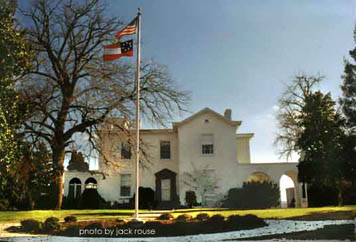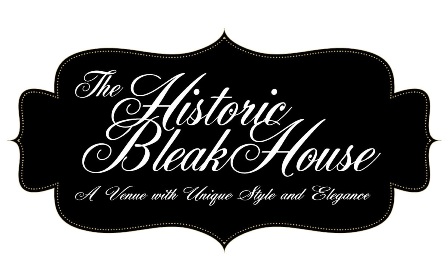
Following
are Frequently Asked Questions and Answers about Confederate
Memorial
Hall (Bleak House). The questions
were gleaned from groups
and individuals that visit for tours or reserve
the Hall for weddings,
receptions, and other social events. The questions are grouped by topic as
follows:
Historical
Architecture and Furniture
Grounds
Tours
Historical:
Q.
Was this the only headquarters that General Longstreet and his men occupied
in Knoxville?
A. General Longstreet
left the battle of Campbells Station on November 16, 1862, pushing the
retreating enemy toward Knoxville. He arrived at Bleak House sometime
on the 17th and established his headquarters. He may have stopped at Knollwood
for a few hours. Other Confederate officers occupied Crescent Bend just
up the street. The entire staff left Knoxville on December 4, 1863, en
route to the Battle of Chickamauga.
Q. Was anyone actually
killed in the house?
A. We know that at
least one Confederate sharpshooter was fatally wounded in the tower; others
were wounded. We don’t have good information beyond that. A drawing on
the tower wall by a soldier-artist depicts the wounded men.
Q. Did the sharpshooters
actually kill Union troops from the tower?
A. Yes. At distances
of several hundred yards. On November 18, 1863, Union General William
P. Sanders was a notable casualty. The Confederate sharpshooters were
using British Whitworth rifles that cost 12 – 15 hundred dollars each
at the time. The rifles were known to be used with telescopic sights;
and, with their hexagonal bores, were accurate at over 1,000 yards.
Q. Is there a monument
here to the troops involved in the battle?
A. The monument to
the Confederate troops is on 17th Street. There is a monument to Union
units on 15th Street. These were the scenes of large dedication gatherings
in the late 19th and early 20th century.
Q. Did the occupants
of the house (the Armstrongs) volunteer the house for use by Longstreet?
A. No one knows for
sure, but it was (and still is) customary for moving armies to commandeer
houses and other necessities during times of war. Most officers, being
gentlemen by definition, treated the owners and the property with as much
respect as was possible.
Q. Were the Armstrongs
sympathetic to the South or to the North?
A. There are divergent
opinions on this, but Mrs. Matheny, a great granddaughter of the Armstrongs,
said that the Armstrongs were strong Southern supporters. Of course during
occupation, there are tendencies for local citizens to be wary of appearing
too partisan. Many people changed sides conveniently, depending on who
had the upper hand.
Q. Did only officers
stay at Bleak House?
A. Higher ranking
officers and aides were probably the only military personnel in the house,
but lower grade officers and enlisted men were camped all over the grounds.
General Longstreet used the present Meeting Room as his office. He may
have slept in the same room.
Q. Did the Armstrongs
stay in the house during the conflict, and were they well treated.
A. We know that they
remained in the house. They were assigned the upstairs back bedrooms,
away from the direction of the battle. So far, extensive comments by the
Armstrongs have not been published.
Q. How did “Bleak
House” get its name?
A. The house was
named after the Charles Dickens novel, which was very popular at the time.
The newly-married Armstrongs, on their honeymoon in England, selected
the name as a “play on words,” because the name “Bleak House” was just
the opposite of the reputation of the Armstrongs – a cheerful couple who
loved parties.
Architecture
and Furniture:
Q. Bleak House doesn’t look like most of the
Greek Revival homes usually envisioned as the style of Southern plantation
houses. What architectural style is the house?
A. It is an Italian
villa style house known as “Tuscan” or “Tuscany.” Actually, the Italian
and other European style homes were popular during the period. Most have
been torn down; a few have survived with extensive changes. While this
house has been changed tastefully over the years, the original character
remains.
Q. Where did the
building materials come from?
A. We assume that
the wood was cut locally. At that time there were a number of millwork
shops in the area. The bricks were hand made at the site. Of course the
original slate roof would have been imported.
Q. Is the furniture
in the house original?
A. A few articles
have been given by the Armstrong family. Most of furniture is not “original,”
because three families in succession owned the house. But the furniture
is period or earlier. Individuals and estates have given many pieces.
Included are 18th century pianos, a circa 1810 “Lazy Susan” serving table,
and the beautiful, ornate 19th Century European bed owned by a local leader
who was killed in an infamous gun battle.
Q. Are the floors
and walls original?
A. The original floors
were heart pine. They were covered with oak by the second owners – some
say to cover bloodstains. The walls are original, but most of the original
hand painted decorations have been covered. There are sections of the
original that have been restored.
Q. Are there battle
markings on the house?
A. Yes, many. During
recent maintenance a worker was discovered filling some of the dozens
of bullet holes with putty. The putty was removed.
Q. Are there many
artifacts on display?
Y. Yes. A portion
of the second floor is used as a museum. Items on display include weaponry
of the period, period clothes on mannequins, newspapers from the siege
of Vicksburg printed on the back side of wallpaper, old photographs, and
period newspapers. One of the most interesting collections is the display
of items for children – including a 19th century walker for toddlers.
Q. Is there a library?
A. One of the area’s
most extensive collections of historic books, including many first editions,
is maintained in the large library room. In earlier times, it was a second
story Ballroom.
Q. I have heard that
GHOSTS have been seen or sensed in and around the house. Is that true?
A. We have heard
similar stories: faces at the windows of the tower, items in the house
moving, drafts in closed rooms. Those kinds of stories are inevitable
with historic homes. But we know of no harm from either the stories or
the ghosts. We refer to them as “friendly” ghosts.
Grounds:
Q.
Was the property, reaching from Kingston Pike to the river, about the
same as now, and was it a city dwelling?
A. No. The original
estate was a working plantation of several hundred acres. In those days
it was in the country – beyond the outskirts of town. Only three and one-half
acres remain. But it is probably at least as valuable now as then.
Q. Are the gardens
original to the house?
A. The gardens were
completely developed around 1906 by the second owners, the Browns. Mrs.
Brown spent large sums of money and tremendous time in planning and developing
the five terraced levels to the river. The reinforced concrete structures
were a new technology, and there were no concrete trucks in those days.
Hand work and work animals were required for all construction.
Q. Have the gardens
changed much since Mrs. Brown tended them?
A. Yes, a great deal.
They are almost 100 years old; their beauty IS their age. We still spend
a lot of time – mostly volunteer labor – getting them ready for YOUR wedding.
Tours:
Q. Are all rooms open during tours and public
events?
A. Unlike many historic
homes, all of the rooms and hallways are open for tours and events except
for two areas – the “Blue Room” and the “Rose Parlor.” These may be viewed,
but they are roped off because of the valuable, historic carpets.
Q. Are there events
at the Hall which are open to the public?
A. Yes. In the spring,
in conjunction with the Dogwood Arts Festival, a Living History weekend
is held. Reenactors demonstrate how the soldiers and civilians lived while
fighting “The War.” Tents, equipment displays, and cannon abound, and
antebellum fashion shows, formation rifle firing and cooking exhibitions
are held. Check the Dogwood Arts Schedule, look at this website, or call
the Hall for exact times and features.
Q. Is there a gift
shop?
A. A gift shop was
opened recently. Visitors may purchase books pertinent to the history
of the house. Flags, pictures, children’s educational items, and other
“difficult to find” things are also available there.
Q. Is it possible
to schedule group tours or educational tours?
A. We will accommodate
special tours for groups of both adults and children. We can also arrange
special educational tours geared especially to the interests of children
and young adults. Special rates may be available.
|

